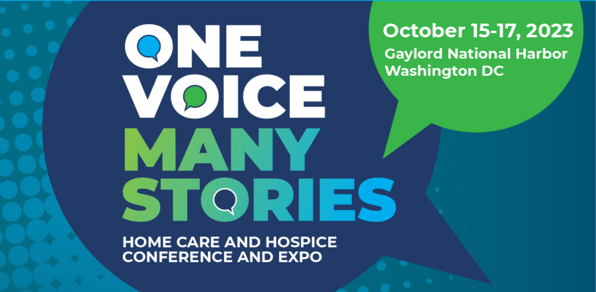Unpacking NAHC 2023: Key Takeaways

The 2023 Home Care and Hospice Conference and Expo, hosted by the National Association for Home Care and Hospice (NAHC), wrapped up on October 17, 2023. This year’s conference did not disappoint, offering a wealth of valuable information for attendees. It shed light on health data exchange, the state of our nurses, and the integration of tech in homecare settings. Here are the highlights and key takeaways from this year’s sessions.
1. Interoperability and Care Coordination
In home healthcare, patients often require coordinated care from multiple providers. As care evolves, seamless data exchange plays a crucial role in getting patients the care they need. However, only 39% of post-acute care providers upgraded their interoperability in 2023.
More agencies need to step up and implement modern systems for value-based care, which will help improve overall care quality and boost patient satisfaction. Outdated technology and inefficient systems waste time and often lead to inaccurate reporting, which can negatively impact patient care. Interoperability streamlines the communication process and makes reporting more efficient, allowing home healthcare providers to treat their patients more effectively.
Interoperability refers to the ability of various information systems, devices, and technological applications to coordinate and connect. With these systems in place, home healthcare agencies can access and exchange patient data better to optimize patient outcomes.
Post-acute care providers are still using phone calls and emails to exchange data, but 99% of referral sources would prefer to send their referrals to providers that could accept them electronically. Interoperability solutions not only benefit care agencies in terms of generating more referrals but also allow them to update referral sources on patient progress and other information.
With the right solutions, home healthcare and hospice agencies can coordinate care more effectively. These systems allow for faster turnaround on orders while remaining in compliance with relevant laws and regulations like HIPAA. Technology also makes it possible for care teams to update patient records in real-time using a mobile app, allowing every member of the care team to access the most recent data. When a patient needs to work with multiple specialized care providers, each member of the care team can follow a specific treatment plan rather than having the patient explain their situation multiple times.
2. Tackling Employee Burnout
Healthcare had a high burnout rate before the COVID-19 pandemic, but turnover in the industry has increased following the pandemic. In 2022, 25% of healthcare professionals surveyed indicated they were considering leaving the industry. Of these respondents, 89% cited burnout as the main reason.
Burnout is a constant feeling of exhaustion accompanied by increased feelings of separation from one’s job and/or heightened cynicism toward it. While burnout commonly leads to job abandonment, it can also cause insomnia, alcohol or substance misuse, and other health problems. Tackling burnout remains a critical issue that home healthcare and hospice providers have to face in the coming years. Healthcare professionals have been working on the issue, and satisfaction levels are rising. However, over half of nurses still report feeling burnt out.
In an NAHC session addressing burnout, presenters noted that the highest burnout rates occur in job roles requiring employees to train intensely for their first three years. The session noted that the greatest variability in burnout happened between years 7 and 9.
Although the rate of burnout is returning to manageable levels, it’s important for healthcare providers to address it before it negatively impacts their caregivers. One way to do so is to create a supportive environment encouraging employees to prioritize their mental health.
In the home healthcare and hospice sector, leadership teams are taking the initiative to help their employees recognize signs of burnout. Forward-thinking leaders create an environment in which care team members can safely talk about stress and feelings of burnout. They understand that burnout is part of the nature of the job but encourage their team members to reach out before they become overwhelmed.
Many leaders are also working on streamlining processes to cut back on the amount of tedious work their caregivers have to do in a day. This gives staff time to focus on patient care or take a much-needed day off.
3. The Future of AI in Home Health
Advances in artificial intelligence (AI) have rocked multiple industries in the past year, and home healthcare and hospice are no exception. Intelligent software is helping care providers and other members of home healthcare and hospice agencies automate tasks and improve patient care without taxing their human resources.
AI involves using a variety of machine learning mechanisms and tools to automate repetitive tasks with limited to no input from people. According to the NAHC presentation on AI, less than 3% of home health and hospice agencies are currently using AI. However, these tools could potentially revolutionize the industry.
Healthcare researchers have been studying how well AI works to diagnose patients using algorithms and other data. In one study, AI caught sepsis six hours before it would have been caught using traditional methods. These tools enable care providers to diagnose and treat critical conditions earlier than they may otherwise be able to. In some cases, this could mean the difference between life and death for a patient.
While other uses of AI are not nearly as dramatic, they are still beneficial. Home health providers and hospice agencies can use these tools to develop integrated document management workflows, saving their caregivers time on paperwork. With these resources, all of the patient's documents are stored in one place, allowing the team to follow a seamless care plan.
Care agencies can also automate invoice approvals and other time-consuming tasks that typically delay payments.
WorldView’s Healthcare Solutions
WorldView offers innovative healthcare solutions that align with trends outlined at NAHC. We provide digital tools to help healthcare providers improve their efficiency, allowing them to spend more time in patient care.
We also value sharing tips and tricks to improve healthcare operations to make life easier for employees and patients alike. Take a look at some of our resources to learn about trends shaping the industry and other valuable information.
Get Awesome Content Delivered Straight to Your Inbox!
Posts by topic
- Healthcare
- Business
- AI
- Hospice
- AP Workflows
- Home Care Management
- hospice-care
- General
- Industry Insights
- agency
- Blog
- Commercial
- reporting
- Data Analytics
- billing
- referrals
- News
- Referral AI
- business goals
- Operations
- business development
- partners
- Integration
- Healthcare Trends
- leadership
- Medicare
- Compliance
- audit
- medicaid
- Better Charting
- regulations
- Application
- Automation
- finance
- CRM
- DMSi
- Events
- KanTime
- Press Release
- Revenue Growth
- Announcements
- Artificial Intelligence
- EHR
- ESign
- Guides
- Homecare Homebase
- Mobile
- Physician Order Tracking
- axxess
- clinical
- interoperability
- payor See All See Less


.png?width=596&name=WV%20Hc%20Clinical%201%20Web%20(3).png)
.png?width=596&name=WV%20Hc%20Clinical%201%20Web%20(2).png)
.png?width=596&name=WV%20Hc%20Clinical%201%20Web%20(5).png)